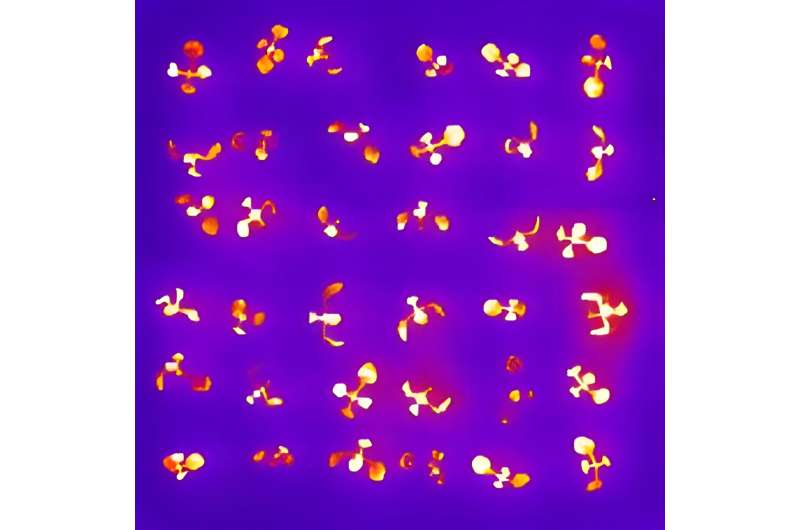This article has been reviewed according to Science X's editorial process and policies. Editors have highlighted the following attributes while ensuring the content's credibility:
fact-checked
peer-reviewed publication
trusted source
proofread
Researchers uncover biological circuit that offers a new avenue for creating drought-resistant crops

Climate change is already harming agricultural yields and may one day pose a significant threat to the world's food supply. Engineering more resilient crops, including those able to thrive in the face of drought or high soil salinity levels, is an increasingly urgent need.
A new study from the Keck School of Medicine of USC reveals details about how plants regulate their responses to stress that may prove crucial to those efforts.
Researchers found that plants use their circadian clocks to respond to changes in external water and salt levels throughout the day. That same circuitry—an elegant feedback loop controlled by a protein known as ABF3—also helps plants adapt to extreme conditions such as drought. The results were published in the journal Proceedings of the National Academy of Sciences.
"The bottom line is plants are stuck in place. They can't run around and grab a drink of water. They can't move into the shade when they want to or away from soil that has excess salt. Because of that, they've evolved to use their circadian clocks to exquisitely measure and adapt to their environment," said the study's senior author, Steve A. Kay, Ph.D., University and Provost Professor of Neurology, Biomedical Engineering and Quantitative Computational Biology at the Keck School of Medicine and Director of the USC Michelson Center for Convergent Bioscience.
The findings build on a long line of research from Kay's lab on the role of circadian clock proteins in both plants and animals. Clock proteins, which regulate biological changes over the course of the day, may provide a shrewd solution to an ongoing challenge in crop engineering.
Creating drought-resistant plants is difficult because plants respond to stress by slowing their own growth and development—an overblown stress response means an underperforming plant.
"There's a delicate balance between boosting a plant's stress tolerance while maximizing its growth and yield," Kay said. "Solving this challenge is made all the more urgent by climate change."
Finding the feedback loop
Previous plant biology research showed that clock proteins regulate about 90% of genes in plants and are central to their responses to temperature, light intensity and day length, including seasonal changes that determine when they flower. But one big outstanding question was whether and how clock proteins control the way plants handle changing water and soil salinity levels.
To explore the link, Kay and his team studied Arabidopsis, a plant commonly used in research because it is small, has a rapid life cycle, a relatively simple genome and shares common traits and genes with many agricultural crops.
They created a library of all of the more than 2,000 Arabidopsis transcription factors, which are proteins that control the way genes are expressed under different circumstances. Transcription factors can provide key insights about regulation of biological processes. The researchers then built a data analysis pipeline to analyze each transcription factor and search for associations.
"We got a really big surprise: that many of the genes the clock was regulating were associated with drought responses," Kay said, particularly those controlling the hormone abscisic acid, a type of stress hormone that plants produce when water levels are very high or very low.
The analysis revealed that abscisic acid levels are controlled by clock proteins as well as the transcription factor ABF3 in what Kay calls a "homeostatic feedback loop." Over the course of a day, clock proteins regulate ABF3 to help plants respond to changing water levels, then ABF3 feeds information back to clock proteins to keep the stress response in check. That same loop helps plants adapt when conditions become extreme, for instance during a drought. Genetic data also revealed a similar process for handling changes in soil salinity levels.
"What's really special about this circuit is that it allows the plant to respond to external stress while keeping its stress response under control, so that it can continue to grow and develop," Kay said.
Engineering better crops
The findings point to two new approaches that may help boost crop resilience. For one, agricultural breeders can search and select for naturally occurring genetic diversity in the circadian ABF3 circuit that gives plants a slight edge in responding to water and salinity stress. Even a small increase in resilience could substantially improve crop yield on a large scale.
Kay and his colleagues also plan to explore a genetic modification approach, using CRISPR to engineer genes that promote ABF3 in order to design highly drought-resistant plants.
"This could be a significant breakthrough in thinking about how to modulate crop plants to be more drought resistant," Kay said.
In addition to Kay, the study's other authors are Tong Liang, Shi Yu, Yuanzhong Pan and Jiarui Wang from the Department of Neurology, Keck School of Medicine, University of Southern California.
More information: et al, The interplay between the circadian clock and abiotic stress responses mediated by ABF3 and CCA1/LHY, Proceedings of the National Academy of Sciences (2024). DOI: 10.1073/pnas.2316825121. doi.org/10.1073/pnas.2316825121.
Journal information: Proceedings of the National Academy of Sciences
Provided by Keck School of Medicine of USC




















